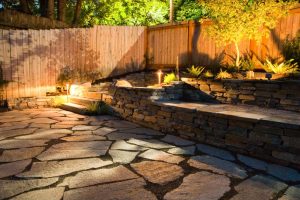In the winter, it can be difficult to keep your landscaped yard from looking stark and bleak. Many plants and flowers either die or lie dormant during the colder months, so bringing color and liveliness to the area often takes creativity and a willingness to think outside the box. One great way to keep your landscape looking fresh and interesting is to include some hardscapes. This perfect option provides visual interest. Hardscapes become focal points, add variety, and can even be functional. The key is to choose the right hardscapes and add them where they will provide the greatest benefit to your landscape. Keep reading if you want to learn how to add hardscapes to winter landscapes in New Jersey.
 Consider your landscaping
Consider your landscaping
Your existing landscaping is a major factor in determining what kind of hardscapes you should add. Chances are you have spent a considerable amount of time and money developing your landscape, and you want your hardscapes to complement and highlight it rather than overtake or overwhelm it. It is best to design both your landscaping and hardscaping at the same time. But, if that is not possible, make sure the landscaping is done first, then add elements such as patios, fountains, walkways, ponds, gazebos, and other hardscaping elements afterwards to add visual interest to the area.
Keep drainage needs in mind
Any actual and potential drainage issues your house and yards have must be considered when developing your landscape to make sure both landscape and hardscape elements are protected from future water damage. If drainage issues are ignored, there is serious potential for all of the elements in a garden to be destroyed. Drainage is particularly important in the winter. When the ground is frozen, it cannot soak up any additional water. Further, any standing water left in the yard will freeze and create hazardous ice patches.
Develop a focal point
Hardscape elements make ideal focal points. Even though the chances are good that you will not be spending much time outside in your garden during the winter, it is still important to have a focal point that will attract attention to the area. Don’t forget that during the winter, even if you are not spending extended periods of time in the garden, you can still view hardscaping elements from indoors. People coming to your house will notice your outdoor elements. Putting in a hardscape element such as a pergola or fountain (sans water in the winter) will keep the visual interest alive and provide something to look at while you wait for your vibrant flowers pop up in the spring.
Choose balanced elements
If the elements of your hardscape and landscape are not balanced, it is impossible to achieve a cohesive look. Even if you are attempting to achieve an eclectic feel, balance is still a key factor. Try to avoid having lines that are too straight and elements that are simply plopped down without any forethought. Including hardscape elements with curves and shapes helps to create a more natural look. Creating a balanced landscape requires time, effort, and planning. Make a sketch of how you want your finished product to look. It can act as a blueprint as you lay everything out and decide which pieces of hardscaping will fit best in your landscape design.
Choose the best materials to fit your needs and style
Hardscapes offer you the opportunity to show off your style. If you know the style you want to achieve, find specific elements that will help you create that look. If possible, choose elements that will complement both your interior and exterior decor. Also, try to use at least two or three different materials in your hardscaping to bring more texture and variety to the area.
Create a path
Walking paths are great additions to any winter landscape. When the earth is frozen and difficult to walk on, it is beneficial to have a path that leads from the driveway to the front door so you and your guests have an easy way to traverse to the house. Adding a path is rather easy. Simply lay down some pavers of your choosing. Pavers come in many different shapes, sizes and colors to suit the tastes and needs of everyone. Early and late winter are the best times to lay pavers down due to the moist, soft ground at these times of the year.
Winter is the perfect time to work on adding hardscaping elements to your landscape. It allows you to keep your landscape up-to-date while you are unable to do much gardening. If you have questions or need help creating your winter hardscape plans, contact a local landscaping professional to get the job done right.
Thank you for reading our blog. How can we help you? Contact us today.
